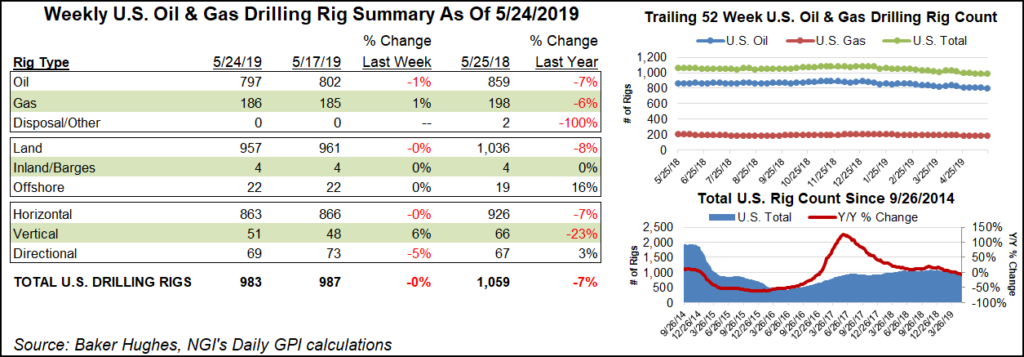NGI All News Access | E&P | Infrastructure
U.S. Adds One Natural Gas Rig; Oil Patch Loses Five, Says BHGE
The U.S. oil patch continued to thin its ranks, losing five rigs during the week ended Friday (May 24), while one natural gas rig returned to work in the Lower 48, according to data from Baker Hughes, a GE Company (BHGE).

Total domestic gas rigs ended the week at 186. The combined U.S. rig count declined by four to 983, compared with 1,059 active rigs at this time last year, according to BHGE.
Land activity declined by four units, while the Gulf of Mexico held steady at 22 rigs, compared with 18 a year ago. Three vertical units were added, while four directional units and three horizontal units were removed from the count.
At the same time, the Canadian rig count ended the week up 15 from last week at 78 (compared with 81 a year ago), including 38 oil rigs, 16 more than last week. The combined North American count added 11 units to 1,061, versus 1,140 in the year-ago period.

Among plays, the Permian Basin and the Cana-Woodford formation each saw three rigs exit during the week, dropping their totals to 451 and 45, respectively. The Mississippian Lime lost two rigs, while the Denver-Julesburg/Niobrara play and Utica Shale each lost one.
On the other side of the ledger, the Marcellus Shale gained two rigs, bringing its total to 62, compared with 56 in the year-ago period. The Eagle Ford Shale and Williston Basin each added one rig.
Among states, the only state gaining more than one rig was California, which added three to reach 18. Three other states each added one rig — North Dakota (to 57), Pennsylvania (to 41) and West Virginia (to 21).
Declines were more widespread. New Mexico lost four rigs to reach 99, compared with 91 a year ago. There were two fewer rigs in Colorado (31), and one rig each was lost in Ohio (to 19), Texas (to 481), Utah (to six) and Wyoming (to 32).
© 2024 Natural Gas Intelligence. All rights reserved.
ISSN © 1532-1231 | ISSN © 2577-9877 |
